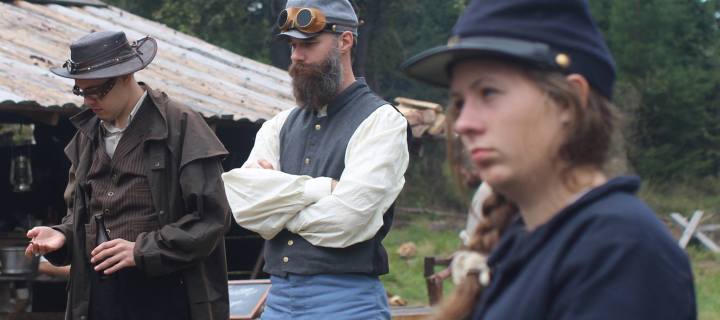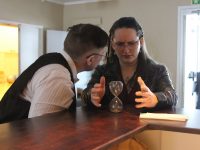A journey through horror, steampunk and mystery
Clockbottom was a larp set in America during the Civil War, with a steampunk twist and elements of horror. About 120 participants from seven different countries gathered during one weekend of September to act out the mysteries in the mining town of Clockbottom. Myself, I played the village’s protestant preacher. It was a role that enabled me to mix with dusty miners, fancy bankers, and everything in between. I liked this a lot, since it allowed me to pursue plots across groups and status levels.
This was my first larp of both the era (1800s) and genre (steampunk/horror). There were both experienced and first-time-larpers among the players, as well as a variety of backgrounds (reenactment, larping, steampunk-nerds, and so on). Since there were participants from all over Europe, the entire larp was played in English with the exception of some characters with Swedish or Danish ancestry (they could therefore speak those respective languages as well).
There is much to say about this larp, not the least regarding the impressive amount of detail in props or the awe-inspiring generosity and inclusiveness in gameplay. I will try to highlight a few phenomenons that stood out in my eyes.
Prologue and the Mine
It is the first time she has had reason to travel down into one of the mines since her arrival in Clockbottom. The air is cold, damp, dark. Yes, it is as if the air itself is dark down there. She cannot help but wonder if this is what being buried alive feels like. The kind woman’s voice instructing them in safety matters upon entering the mine is reassuring though, as is the attentive presence of the timekeepers. She stays close to Witte, knows he will look out for her here as he does in the village. The miners are unrestful, uncertain. What awaits them in here is not only a return to God’s honest work, but a return to the loss of beloved ones. Will there be bodies? A new kind of stench?
One thing that the Clockbottom larp presented, that I have not seen done before, was a prologue. This was a 1-2 hour scene available for those who so desired it, meant to set the tone for the later opening of the larp as well as offering nearly all characters a chance to partake in a common scene no matter their alignments or statuses.
 The prologue took place in the mine that was later used in-game. The organizers struck a good deal with the mine company, in which the larp had the use of the mine for free in return for some real work done in there (shovelling gravel, mostly). To have an actual mine to play in was extraordinary what with feeling, immersion and understanding. Unfortunately the mine itself was located about half an hour by car from the larp village, so travelling between the two meant some off game time for those with characters there.
The prologue took place in the mine that was later used in-game. The organizers struck a good deal with the mine company, in which the larp had the use of the mine for free in return for some real work done in there (shovelling gravel, mostly). To have an actual mine to play in was extraordinary what with feeling, immersion and understanding. Unfortunately the mine itself was located about half an hour by car from the larp village, so travelling between the two meant some off game time for those with characters there.
I initially signed up for the prologue to get to see the mine, as my preacher would not spend in-game time there. However, it soon turned out that it was a magnificent way of trying out your character, build some spontaneous relations and plots, and to bring back a shared experience to the actual larp. It is a concept I would love to see more of at other events, perhaps incorporated among pre-larp workshops like this one was.
A Multitude of Larps in One
They have not yet reached the true conclusion of the cipher when she is presented with two sheets of paper. Apparently they have been found inside the propeller resting by the piano in the bar. She is perplexed, cannot fathom how something so secret can be hidden in plain sight and yet remain unfound until now. The content of the papers shocks her to the core, however, quite unprepared as she is for such truths to unravel after all this time. It is the last will of her predecessor, Reverend Smith. She has found no facts regarding his life before, has been met only with silent tongues and shifting eyes when inquiring among the townsfolk. And apparently there was much more she did not know.
Something that to me speaks of a well-planned or well-played out larp, is when there are “many larps within the larp”. Not only as in different plotlines, but when there are actually different types of stories or sub-larps amongst different parts of the player pool. Clockbottom had this multitude of larps to a great extent. For example, the workers had gang- and poverty-related play, the soldiers had skirmishes and soldier-play, the villagers had everyday village life (intercepted by mysteries), the preachers had a lot of religious play and the scientists had their research and experiments. The company administration even found themselves in a spontaneous meta-larp “by telegraph” (which the organizers ran) around selling and buying company stocks. Naturally, this also becomes a believable backdrop for players not currently participating in a certain sub-story.
 What connected everything more than other plotlines, however, was the great mystery plot of Clockbottom’s darker secrets. I do enjoy mystery solving in a larp, and have played many such roles over the years. One problem that too often arises, is when players figure out the solution “too soon” and are left spending the last day of the larp in some kind of waiting state. I was concerned that this would happen here as well, since we solved a lot of the clues during the first day. Alas, I should not have worried.
What connected everything more than other plotlines, however, was the great mystery plot of Clockbottom’s darker secrets. I do enjoy mystery solving in a larp, and have played many such roles over the years. One problem that too often arises, is when players figure out the solution “too soon” and are left spending the last day of the larp in some kind of waiting state. I was concerned that this would happen here as well, since we solved a lot of the clues during the first day. Alas, I should not have worried.
It is the most extensive mystery plot I have encountered, and with such detail in props and clues. Altogether, there were ciphers and codes in Latin, ancient Greek, hieroglyphs, numbers, Cherokee, Bible references and music, apart from the regular notes, diaries, letters and articles in English. There was a copper tablet inscribed with hieroglyphs, there was a full research journal in a multitude of languages and there was an alluring cryptex. Initially, we were three or four people trying to investigate. On the last day of the larp, we were more like twenty I would say. Also, an aspect that furthered the game was that many characters (pre-written by the organizers) held tiny pieces of the puzzle that only made sense together, thus encouraging those pursuing the truth to inquire amongst any and all in the village.
Horror Effects
The crystal clear notes of the eerie tune will haunt her to the end of her days, she knows it even as she hears it there, for the first time. It holds her in place stronger than the fiercest of chains, marks her mind for insanity as surely as water flows downwards. Not yet perhaps, but it will come. The utter terror that fills her veins makes her simultaneously unable to move and acting on impulse. Her voice sounds strangely strangled as she once more calls out, and no one could ever pretend that her words appear intimidating anymore. It is more of a croak, more of a pointless motion to be gone through. Then a pause, a held breath awaiting an answer while frozen lips pray to a God that is far away, too far away, that none such will come.
But it does. Oh, it does.
 Apart from the steampunk-Civil War genre, Clockbottom was most definitely a horror larp. Several elements aided in this, not the least the full moon and lingering mist that adorned the village every night. However, there were items and events presented by the organizers that truly laid the base for this feeling of terror. Some were more easily achieved, like the melody that became the tune connected with madness, ghosts and devilry, or the use of “shadows” -a meta-technique where certain “non visible” players whisper, coax or otherwise interact with the character players of the larp in a -during this larp – eerie manner.
Apart from the steampunk-Civil War genre, Clockbottom was most definitely a horror larp. Several elements aided in this, not the least the full moon and lingering mist that adorned the village every night. However, there were items and events presented by the organizers that truly laid the base for this feeling of terror. Some were more easily achieved, like the melody that became the tune connected with madness, ghosts and devilry, or the use of “shadows” -a meta-technique where certain “non visible” players whisper, coax or otherwise interact with the character players of the larp in a -during this larp – eerie manner.
Other elements needed more planning. There were tiny sound devices placed around the village, playing five different tracks of “scary sounds” (ie whispers, child’s laughter or scraping noises) at random time intervals. These were really efficient in upping the feel of utter terror, I can confess to that. I must also mention the full-size, very realistic skeleton that was buried in the village graveyard months before the larp. She was unearthed twice during the weekend, and each time it was equally unnerving to find the meter-deep grave gaping open, the nailed-shut coffin lid thrown aside, and the skeleton grinning at us from its grave.
Inter-player Communication
That she has held sermons on top of children’s remains for three years… The thought is unbearable. At last they are gathered; preachers and townsfolk brave enough to take on this gruesome task. Walsh is there, silent and watching. Gibson and Mr Sommer are sturdy and clear-eyed, mayhap they have known about this, or about the murder. The miner who so bravely spoke of crawling in under the church to secure the box is found, and they are ready. Almost – she calls for more lanterns, they must have light. Oh, if they could but have done this in daylight.
Inclusion and playing to lose are two terms that invite you to play generously and humbly (even though your character can be quite the opposite) in order to involve others in your play. The players of Clockbottom did this to such a degree that I was genuinely taken aback. I have not previously seen such generosity and inclusion at any larp I’ve been to, nor how quickly it became a game structure rather than something individual players did.
Taking the great mystery plot as an example, there was never a question of stepping into a closed house with a select few to try and translate the codes. Instead, anyone who curiously lingered by the open table on the main street was invited to share their view on the current matter. Secret notes were shown to any and all who might hold the slightest clue; be it a miner or the company director. When embarking upon tasks in the night or to places we were not supposed to go, there was no real sneaking about. Anyone who happened by was warned about the gravity of the task, but not turned away. What with the plot clues spread all across the board, we probably couldn’t have solved the mystery without including as many people as possible either.
 What the cause for this high level of inclusion is, I don’t really know. Perhaps it was the instruction from the organizers on playing to lose. Perhaps it was a positive outcome from the mixing of larp cultures. Perhaps it was a standard set by in-game decision makers that others followed. Either way, I definitely hope to see more of this inclusive larping at future events I go to (and will of course try to do my part).
What the cause for this high level of inclusion is, I don’t really know. Perhaps it was the instruction from the organizers on playing to lose. Perhaps it was a positive outcome from the mixing of larp cultures. Perhaps it was a standard set by in-game decision makers that others followed. Either way, I definitely hope to see more of this inclusive larping at future events I go to (and will of course try to do my part).
One thing that I found strangely lacking regarding interplayer communication however, was the lack of just that prior to the larp. There was a forum, but only a few people posted there. I know that there were facebook groups for in-game gangs and groups, but as far as I saw they were not announced too clearly on the main event page. Shout-outs on the main event page rendered few replies from players. Since my character did not really belong to any groups, and since I didn’t activate myself in creating groups for, for example, the “holy folks”, I barely had any communication with others before the larp.
I must confess that this silence amongst players made me a bit worried, and it felt rather unusual what with the plot planning and relation building that today counts as standard preparation for any Swedish larp. Now, based on the prologue and in-game initiatives this was not a problem during the larp at all. However, I must think that this could have presented a considerable threshold for people new to larping, or to people more shy or otherwise unsure of how to make contact with other players (unless they were in active groups already).
Final Words
While there have been smaller 1800s/steampunk larps, I think this was the first larger one that catered to a wider community of players. Although a possible cause for hesitation, it turned out that the gear for this setting was not too hard to come about, perhaps even easier than for earlier historical periods. Combined with the enjoyable aspect of meeting people from other larp cultures (nation wise as well as playing style-wise), I heard many express afterwards that this was a style of larping they’d definitely look into more. And I must say, I think there will be a lot more steampunk in the years to come.
A note regarding things not addressed in this article:
There was some discussion prior to Clockbottom, on the topic of the Cherokee being a part of the larp setting and the risks of cultural appropriation. As I neither played a Cherokee character, nor am of an ethnic group exposed to appropriation or negative prejudices, I did not feel best suited to present that here. There are other players much more eligible for that, and I might just miss the right angles due to my own lack of experience in the matter.
All photos in this article are by Ida Mary Walker Larsen.
You can find an in-game short story from Clockbottom by the author of this article, Emma Ström, here:
http://goo.gl/8IfJX5






